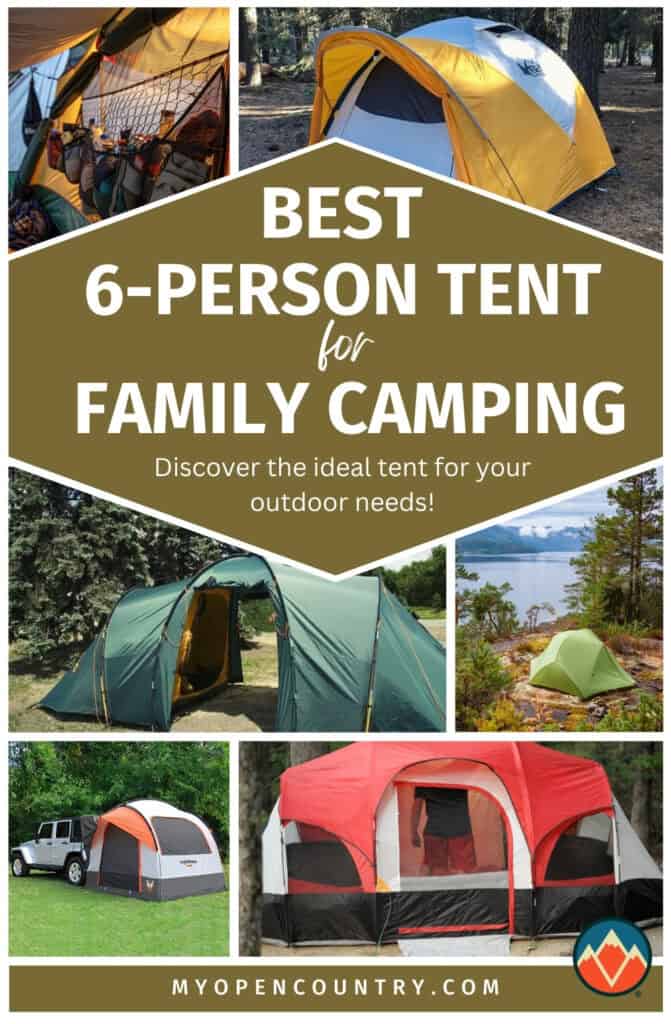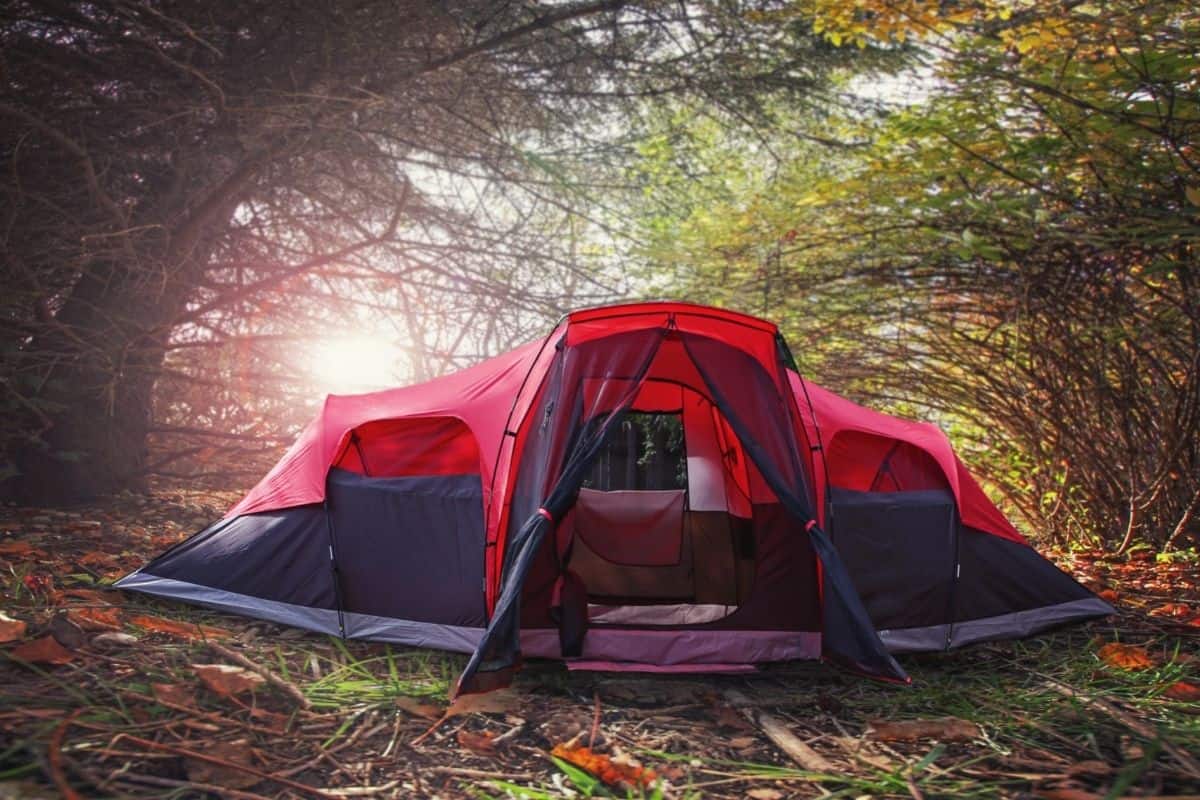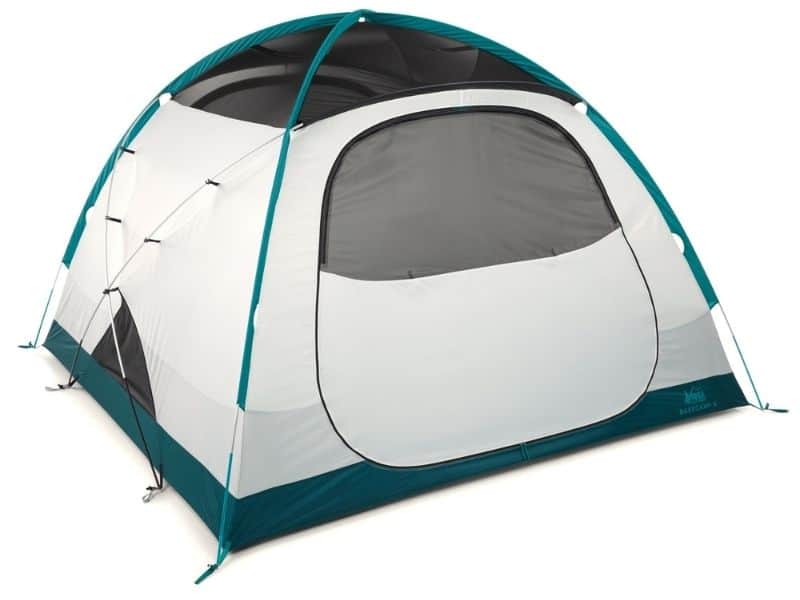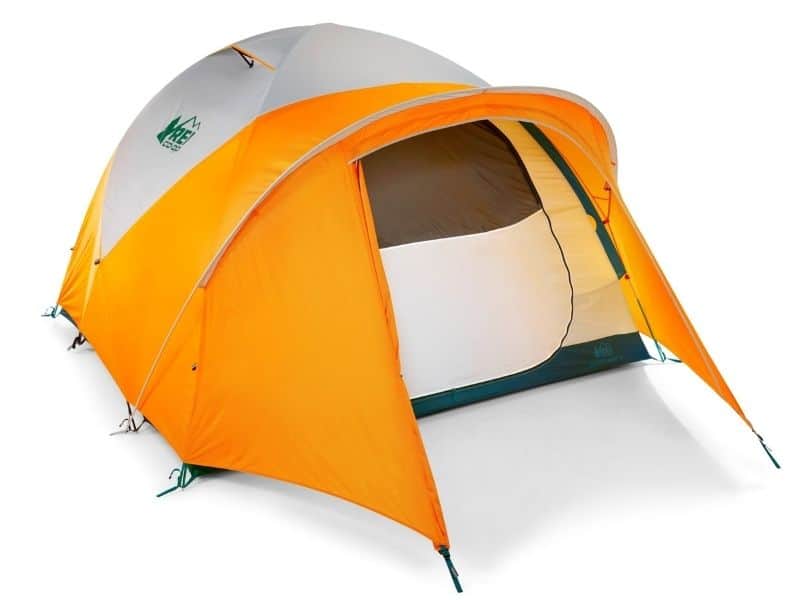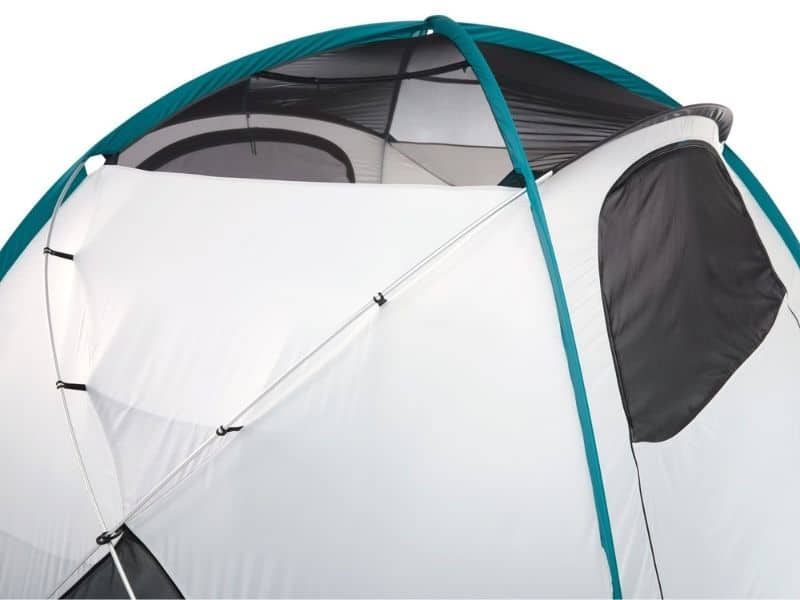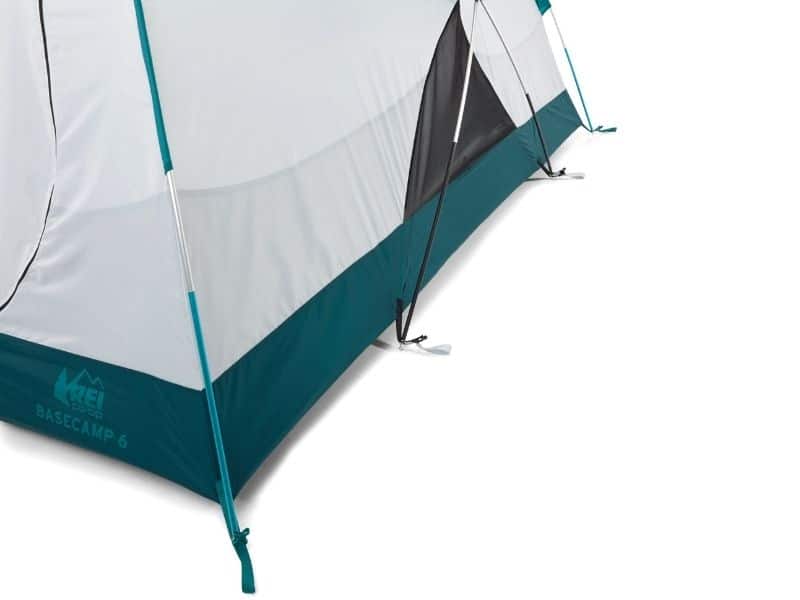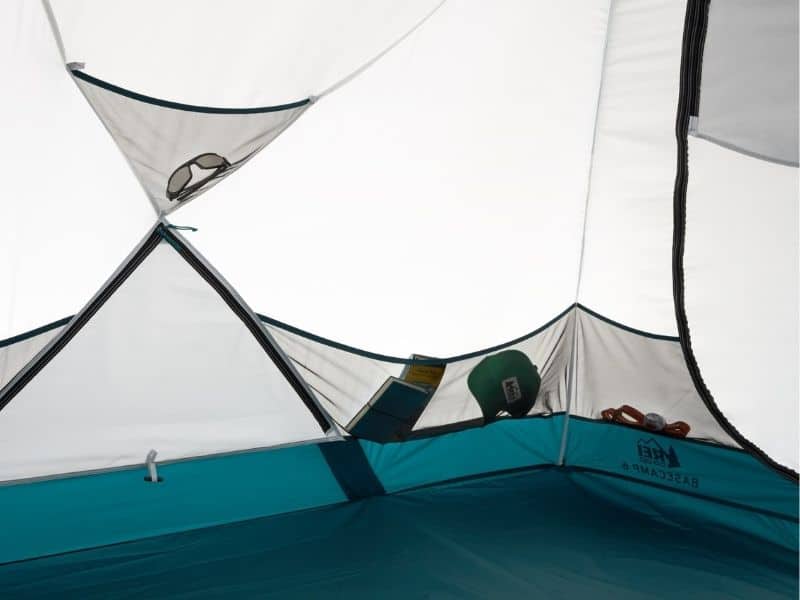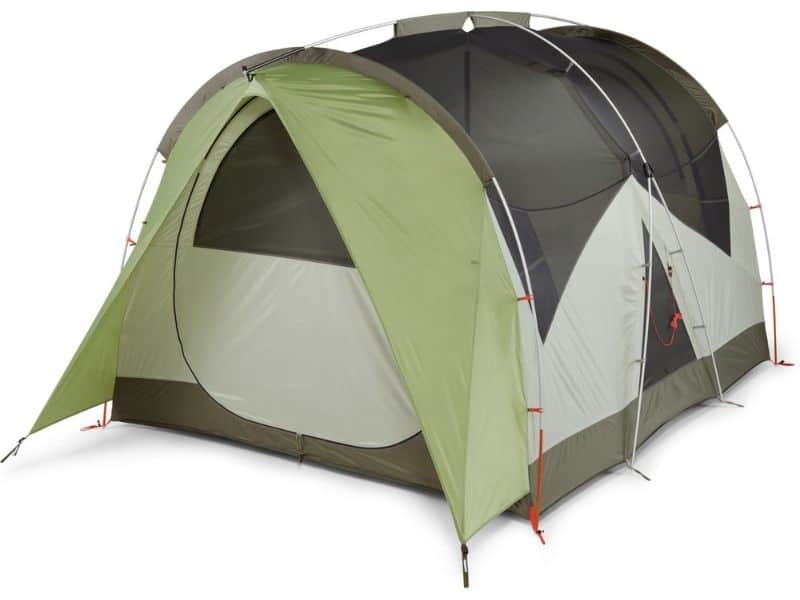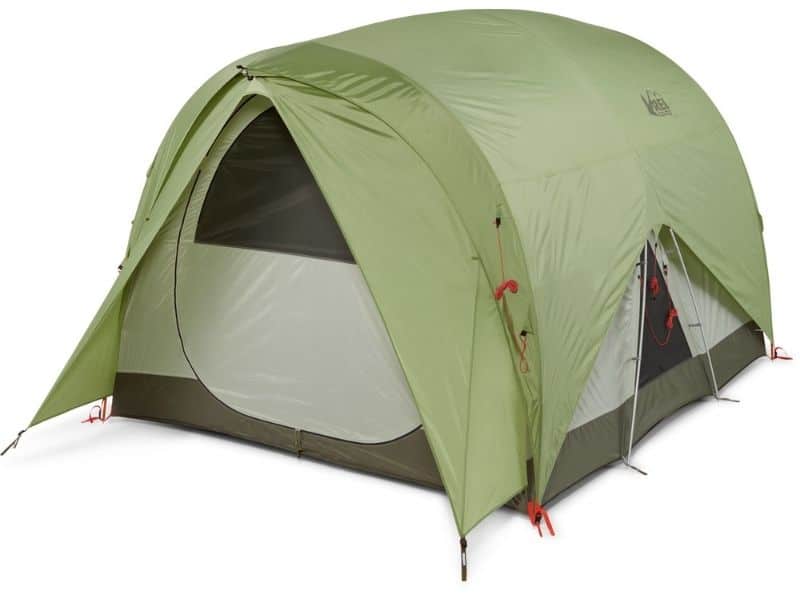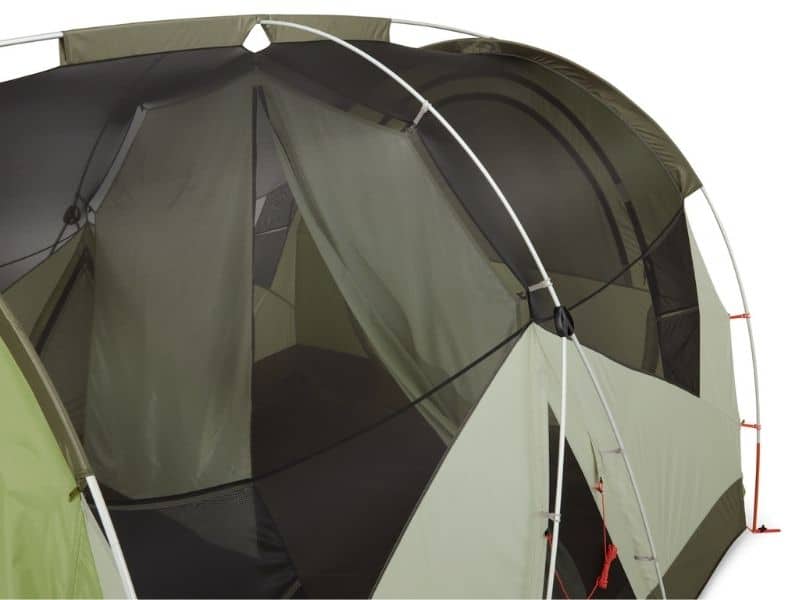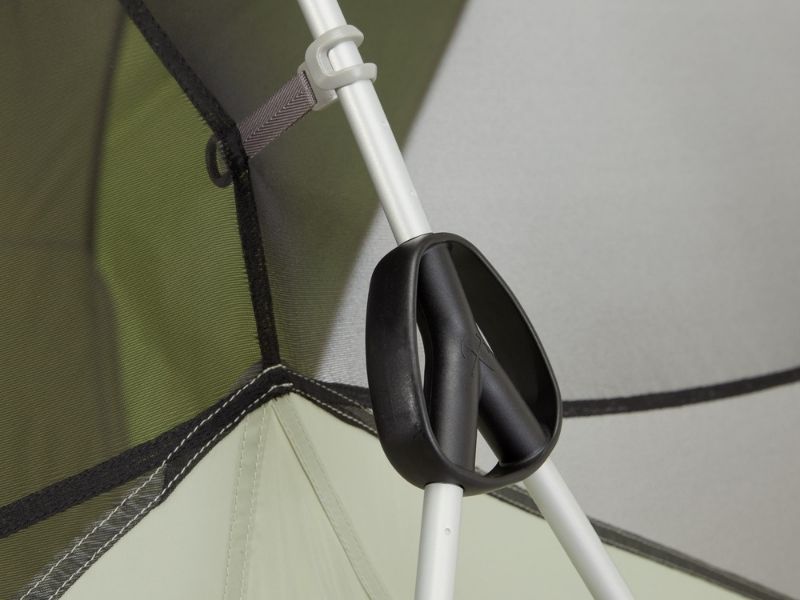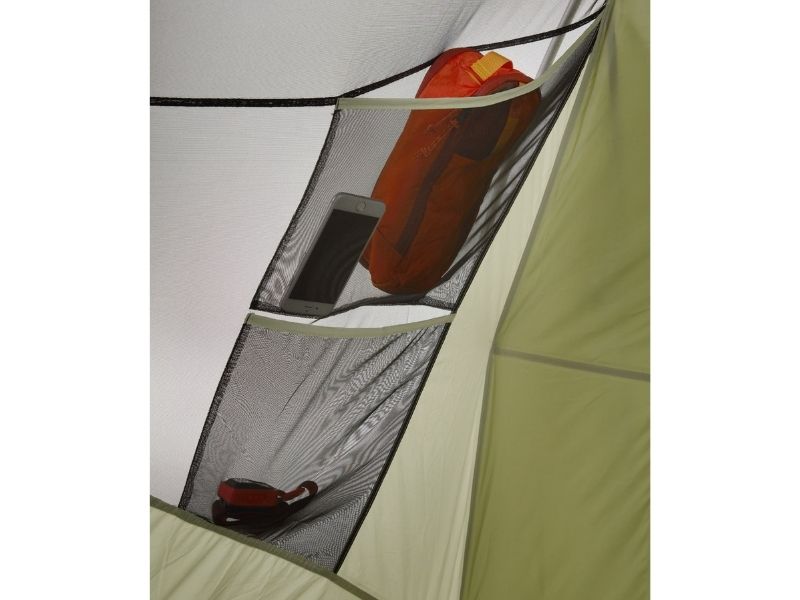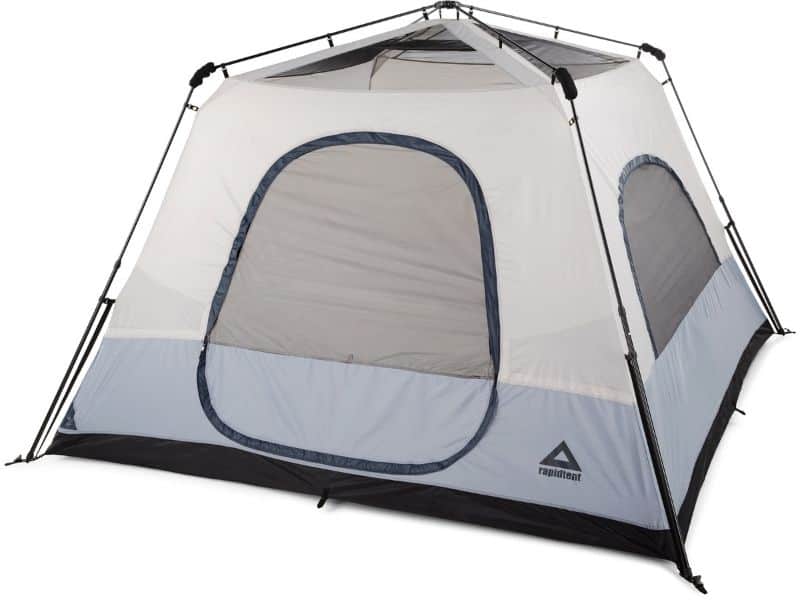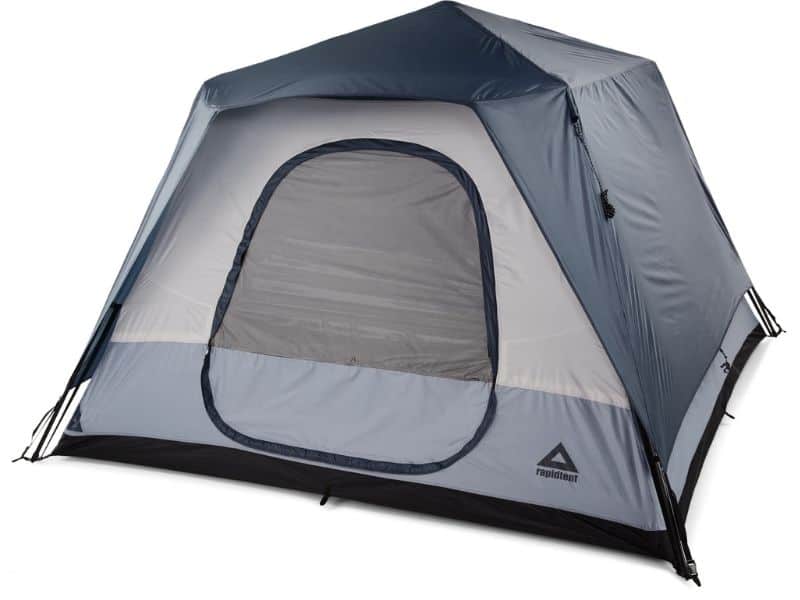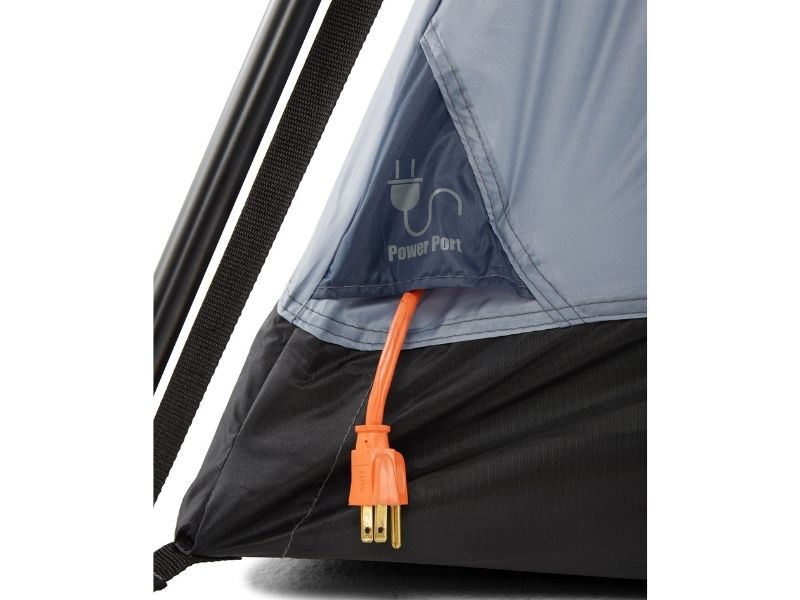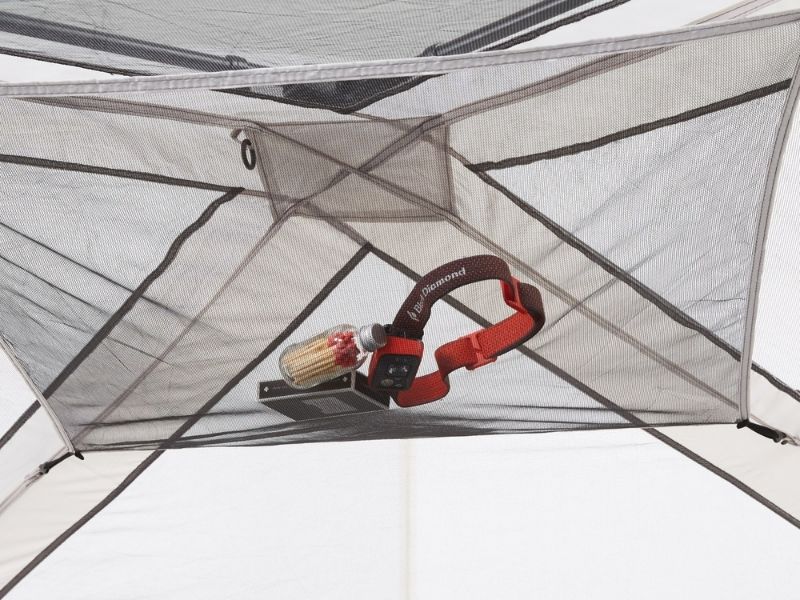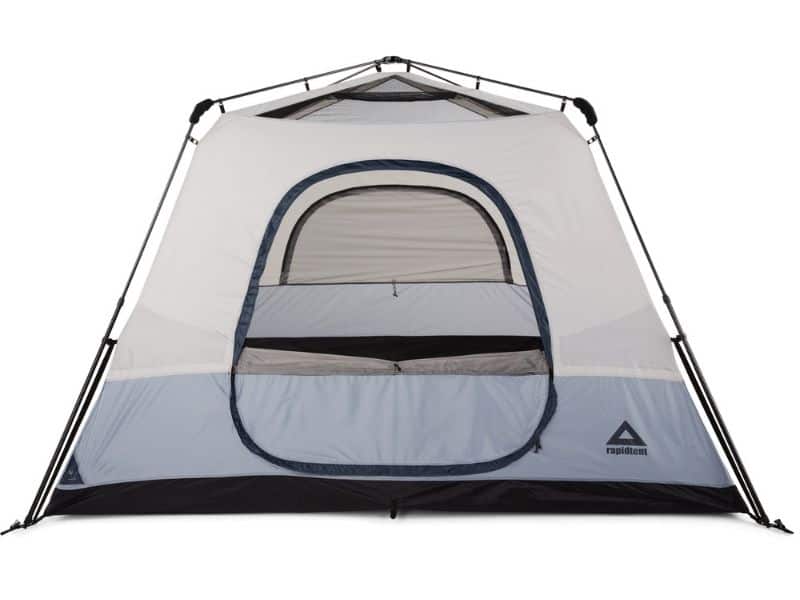When looking for a camping shelter for the entire family or a group of friends, your priorities will differ compared to choosing a solo backpacking tent. That’s why we’ve created this guide featuring the best 6-person tents for different budgets and occasions. From affordable car-camping options to premium tents and durable shelters for unpredictable weather, our list has a tent to suit your needs!
The top-rated 6-person tent in our reviews is the REI Base Camp 6, with the Coleman Sundome 6, REI Wonderland 6, Rightline Gear SUV, Caddis Rapid, and the North Face Wawona 6 also recommended. If you’re still unsure about the right option for you, we cover the key features to look for, including floor area & capacity, peak height, number of doors, weather protection, ventilation, durability, pitching, weight, and storage options.
Save for later!!! ⤵️
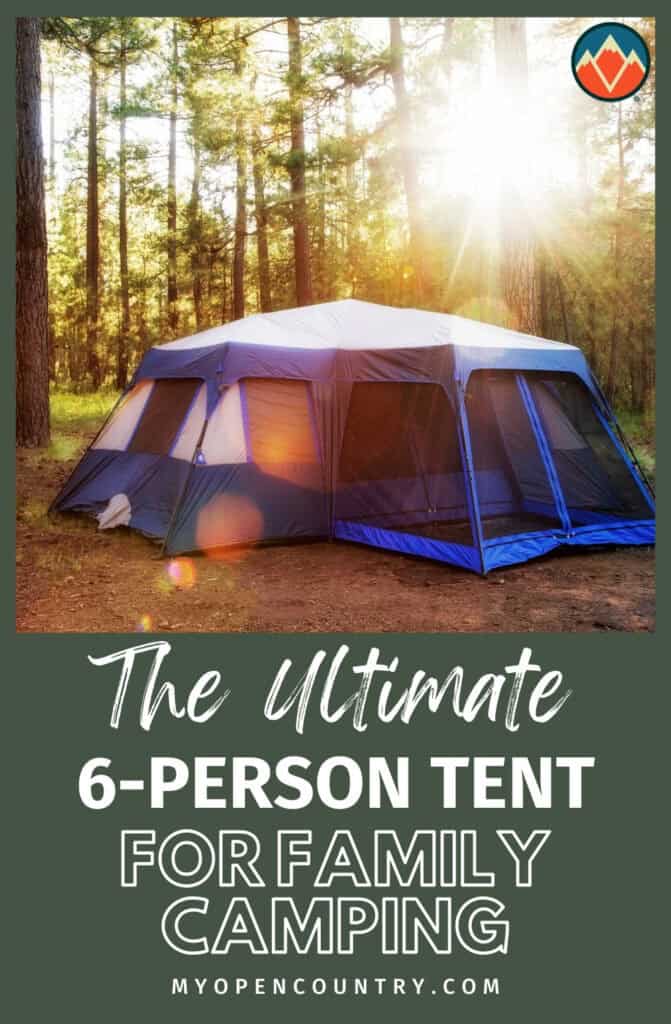
Table of Contents
At a Glance: Quick Recommendations
-
Editor’s Choice:
REI Base Camp 6
“A spacious tent that offers a winning combo of robust weatherproofing, oodles of storage space, and easy pitching” -
Best Budget:
Coleman Sundome 6
“With 100 square feet of living space and weighing just 18 pounds, this is the most spacious and lightest 6-person tent in our review.” -
Best Premium:
REI Wonderland 6
“A sturdy, roomy family camping-cum-luxury tent that has a central divider to allow the interior to be split into two private rooms.” -
Rightline Gear SUV:
Best Tent for SUVs
“This tent is very easy to attach to your vehicle, has an impressive center height, and can also be used as a regular tent.” -
Caddis Rapid 6:
Best Instant
“This incredibly robust shelter can be set up in under two minutes thanks to the use of pre-attached poles.” -
North Face Wawona 6:
Best for Livability
“With 56 square feet of vestibule space, plenty of storage pockets, and a large interior, the Wawona is the ideal pick for campers who tend to feel claustrophobic in less roomy shelters.”
Our Top Picks by category
3–4 Season Tents: REI Base Camp 6 and Rightline Gear SUV
Roomiest: Caddis Rapid 6 and Coleman Sundome
Vestibule Space: REI Base Camp 6 and North Face Wawona 6
What are the Best Six-Person Tents?
In our 6-person tent reviews, we found the REI Base Camp 6 to be our overall favorite, with the recommended other contenders listed below.
- REI Base Camp 6
- Coleman Sundome 6
- REI Wonderland 6
- Rightline Gear SUV
- Caddis Rapid Six-Person Tent
- North Face Wawona 6
REI Base Camp 6
Editor’s ChoiceSeason: 3–4-season ⸱ Living space: 84 sq. ft. ⸱ Center height: 74″ ⸱ Weight: 20 lbs. 10 oz.
The REI Base Camp 6 dome tent provides a genuine “home away from home” feel, making it ideal for family camping trips and earning our editor’s choice award.
This is one of the pricier tents in our review after the REI Wonderland 6 and costs nearly three times as much as the cheapest, the Coleman Sundome. However, that extra outlay buys you an uber-practical shelter that’s built to last a lifetime and fit for year-round camping in a range of locations.
With a peak height of 74 inches and 84 sq. ft. of interior tent space, the Base Camp has ample space for 6 adult sleepers. There’s also more than enough room to store gear with an additional 44 sq. ft. of vestibule space.
The Base Camp is also one of the best 6-person dome tents out there for camping in varied weather conditions. This is thanks to its use of a full-coverage, 1,500mm rainfly, 150d polyester flooring, roof vents, and huge mesh-lined doors.
The dome shape does mean it offers a little less overall headroom than cabin tents with steeper walls like the Caddis Rapid 6, but the Base Camp 6-man tent is a whole 5 lbs. lighter, has two doors instead of one, and uses a double-walled design that makes it less prone to condensation.
PROs
- Lightweight
- Solid weather protection
- Roomy
- Huge vestibules
- Double-doored design
- A good tent for cold-weather camping
CONs
- Not as well-ventilated as other tents
Bottom-Line: An extra-robust, highly weather-resistant dome-style tent that’s suitable for both car-campers and backcountry adventurers alike.
Coleman Sundome 6
Best BudgetSeason: 3-season ⸱ Living space: 100 sq. ft. ⸱ Center height: 72” ⸱ Weight: 18 lbs.
The Coleman Sundome 6 is incredibly budget-friendly for a 6 person family tent and also the most spacious and lightweight model in our list.
It’s also very easy to pitch, has a decent peak height, a frame that’s built to withstand 35+ mph winds, and is light enough to use as a backpacking tent when split between 3 carriers.
There are, however, a few downsides – as is to be expected from such an inexpensive tent.
For starters, the Coleman tent has only a partial rainfly, meaning it lacks the weather resistance offered by full-coverage rainfly tents such as the Weathermaster or North Face Wawona. It also has no vestibules, only one door, and uses fiberglass poles that are unlikely to survive a drop in rocky terrain.
PROs
- Cheap!
- 3000mm rainfly
- Very roomy
- Decent peak height
- Lightweight
CONs
- Fiberglass tent poles
- Only one door
- Partial rainfly
Bottom-Line: This affordable tent makes a few compromises, but its robustness, huge interior, and above-average waterproofing make it great value for money nonetheless.
REI Wonderland 6
Best PremiumType: Tunnel ⸱ Interior Space: 83.3 sq. ft. ⸱ Peak Height: 78” ⸱ Weight: 22 lbs. 15 oz.
The REI Wonderland is the updated and improved version of REI’s popular Kingdom tent, and our recommendation for those seeking a more premium option.
Like its predecessor, the Wonderland uses a tunnel-style design with near-vertical walls that maximize headroom from end to end and side to side. It also has strategic color-coding on the fly, poles, and footprint to make setup a cinch, and combines a “scalloped” fly with extensive mesh panels and windows to provide 360° views, even with the fly on.
On the face of it, the Wonderland’s 83.3 square feet of floor space and 78” center height make it a roomy 6-person tent. However, unlike most tents on our list, it has no vestibule area, only a duo of small awnings that provide a sliver of cover over the doorways.
Like most REI shelters, this tent features are on the nail. You get a ton of interior pockets for gear storage, vents at top and bottom to stave off stuffiness and condensation, hanging hooks for a lantern or headlamp, and two extra-large doors that extend from top to bottom and wall to wall.
A center partition wall also zips into place to divide the interior into two separate rooms, making it a great choice of shelter for families or groups who like a little extra privacy come bedtime.
PROs
- Roomy interior
- Stable in strong winds
- Room divider
- Easy to set up
- Plenty of pockets
- Durable materials (75D fly, 150D floor)
CONs
- Heavy
- No vestibule
- Partial-coverage rainfly
Bottom-Line: A well-made three-season tent that’s ideal for car-camping families – as long as you don’t need too much storage space.
Rightline Gear SUV
Best for SUV CampersSeason: 3–4-season ⸱ Living space: 57.6 sq. ft. ⸱ Center height: 80.4” ⸱ Weight: 20 lbs.
The Rightline Gear SUV is our top choice for campers who prefer sleeping in their vehicle yet also like to have extra tent space for their gear, kids, or camping companions.
The Rightline may only have a partial rainfly, but its tape-sealed seams, bathtub flooring, and the 2,000 mm HH rating of the fly mean it offers robust enough weather protection for most three-season outings.
Compared to other SUV tents we’ve tried in the past, this one felt a lot more livable despite its fairly scanty floor space. This owes mainly to its impressive center height and the plentiful interior storage options.
The Rightline can be used either with a vehicle or as a standalone shelter. While adequately roomy when used attached to your SUV, it’s worth noting that its 57.6 sq. ft. dimensions mean it’s best described as a 4-person tent when used sans vehicle.
PROs
- Can be used with or without a vehicle
- Tape-sealed seams
- Waterproof (2,000mm HH)
- Vehicle Sleeve seals around any size of SUV, minivan, wagon, or pick-up
- Great peak height
CONs
- Partial rainfly
- Only enough space for 4 when used without a vehicle
- No vestibule or screen room
Bottom-Line: A well-made, super-convenient car-camping tent that can also moonlight as a standalone shelter.
Caddis Rapid Six-Person Tent
Best InstantSeason: 3-season ⸱ Living space: 100 sq. ft. ⸱ Center height: 80” ⸱ Weight: 25 lbs. 8 oz.
Our favorite 6-person instant tent, the Caddis Rapid 6, exemplifies the significant advancements made by instant tents as compared to their predecessors. In the past, instant tents were often avoided by “serious campers” due to their cumbersome weight, bulk, and typically cheaper construction.
However, the Caddis is, simply put, a cabin-style tent that combines the convenience of an instant with the performance and practicality of a traditional tent. It boasts a generously sized rain fly, has 100 sq. ft. of interior space, is made with superbly robust, high-quality materials, and yet can be set up in under two minutes thanks to its use of pre-attached poles.
The vertical walls and lofty center height of the Caddis also give it a roomier feel than any other tent in our review. However, its lack of any form of vestibule and its less impressive waterproofing means we favor the REI Basecamp and North Face Wawona for livability and camping in less-than-perfect conditions.
PROs
- Very easy to set up
- Spacious interior
- Plenty of headroom
- High-quality materials
- Multiple windows
CONs
- Partial-coverage rainfly
- Bulky
- Has only a few storage pockets
- No vestibule or screen room for wet/dirty camping gear
Bottom-Line: Boasting 100 square feet of interior space and pitching in under 2 minutes, this beast of a shelter is a great pick for campers who value convenience and livability.
North Face Wawona 6
Best for LivabilitySeason: 3-season ⸱ Living space: 86.11 sq. ft. ⸱ Center height: 80″ ⸱ Weight: 20 lbs. 15 oz.
The North Face Wawona 6 stands out as the most livable tent in our list, offering an impressive 56 sq. ft. of vestibule space, 86.11 sq. ft. of interior space, and abundant storage options in the tent roof and walls.
But this shelter has a lot more to offer than just a sh*t ton of storage and living space.
While the Wawona’s partial-coverage rainfly doesn’t offer as much weather protection as the REI Base Camp, it is more than capable of fending off light rain showers. Where it does outshine this REI tent is with its huge mesh front door, ceiling vents, and extensive mesh roof, providing superior airflow and making it a better tent for warm-weather camping.
The Wawona is also amongst the most robust and lightweight tents in our review. And while it might take a little longer to pitch than either the Caddis or the REI tents, in return for the extra effort you get a shelter with dimensions that border on simply palatial.
PROs
- Huge vestibule area
- Great storage options
- Center height
- Lightweight
- Double-wall construction
CONs
- Only 1 door
- Partial rainfly
Bottom-Line: The perfect tent for family trips or campers who take an “everything but the kitchen sink approach” to gear selection.
How to choose the Best Six person tent for your needs?
When purchasing a 6-person tent, it’s essential to consider specific features and options. In the list below, we highlight the important factors to keep in mind.
- Floor Area & Capacity
- Peak Height
- Number of Doors
- Weather Protection
- Ventilation
- Durability
- Setting Up & Taking Down
- Weight
- Storage
Floor Space & Capacity
The most accurate method to determine tent capacity is to check the product specifications for the total square footage of floor space.
The average adult sleeper needs around 14 square feet of floor space for a comfortable night’s sleep. Knowing this, you can divide the tents living area’s total square footage by the number of peeps you plan on camping with to determine whether or not your would-be backcountry bolthole is going to feel more like a castle or a coffin for your camping crew.
All tents are sold with a “person rating” (2-person, 4-person, 6-person etc.). While these ratings can give you a rough idea of how many sleepers a tent can accommodate, they’re best taken with a large pinch of salt since tent manufacturers often use them to make their tents seem roomier than they actually are.
The more castle-like tents in our review – with regards to roominess – are the Caddis Rapid 6 and Coleman Sundome, both of which have a 100 sq. ft. floor area.
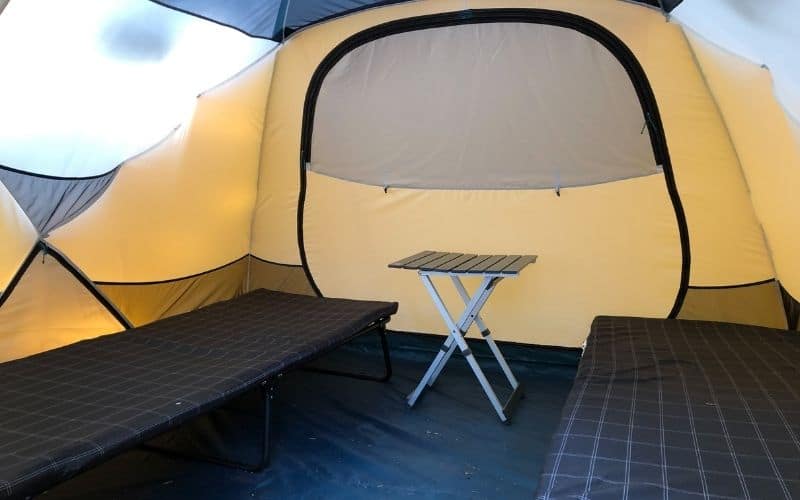
Peak Height
Peak or center height refers to the height of the tent at its tallest point. This measurement is important as it affects how easy it is to move around inside and the general livability of the tent.
The tents in our review have peak heights ranging from 72” (Coleman Sundome 6) to 80” (Rightline Gear SUV).
Number of Doors
A single-door shelter is suitable for solo campers or couples, but for group camping, double-door tents offer greater convenience and practicality.
Having two doors makes it easier to get in and out allowing you to sneak out to answer nature’s calls without waking or disturbing your tentmates, on top of that it also improves ventilation.
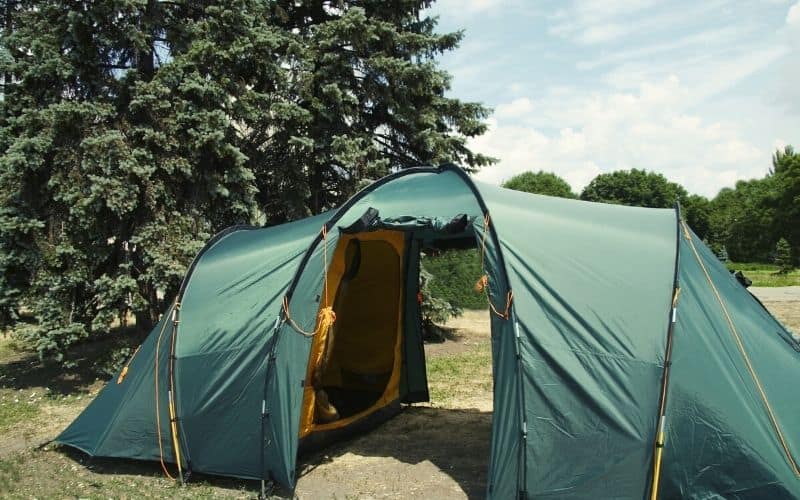
Weather Protection
To determine the level of protection a shelter offers against inclement weather, the key attributes to consider are seasonality and waterproofing.
Seasonality
When buying a camping tent, the seasonality or rating (2-season, 3-season, or 4-season) provides a general idea of the conditions for which it’s intended to be used in
- 2-season tents: Ideal for summer camping when you expect high temperatures and little or no precipitation, these tents offer plenty of ventilation but poor weather protection.
- 3-season tents: The most versatile option because they can be used in spring, summer, and fall. Capable of withstanding heavy rain and strong winds. In warm and dry conditions, simply remove the fly for added ventilation.
- 4-season tents: Aka “winter camping tents”, these are designed to withstand extreme weather – strong wind, driving rain, sleet, and snow. Their added weather resistance will however result in decreased breathability and ventilation, making them unsuitable for use in warmer weather.
All of the tents featured in our review are 3-season tents except for the REI Base Camp 6 and Rightline Gear SUV, which both have robust enough weatherproofing to straddle the ground between a 3- and 4-season rating.
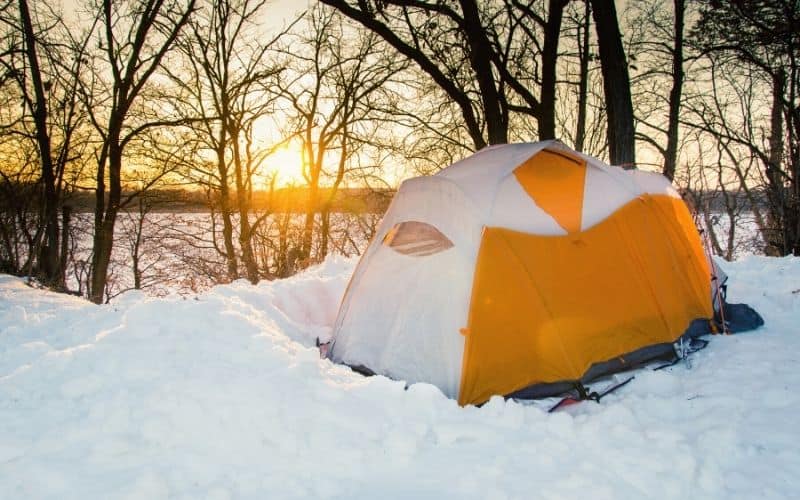
Waterproofing
Tent fabric waterproofing is measured using the Hydrostatic Head (HH) open-column water test. This test determines the level of water pressure a fabric can withstand before it begins to leak.
HH ratings are given in mm (i.e.1,500mm HH, 3,000mm HH, and so on), and the higher the figure, the more waterproof the fabric will be. For three-season camping, we recommend a shelter with a minimum 1,000mm HH rainfly and 1,500mm flooring.
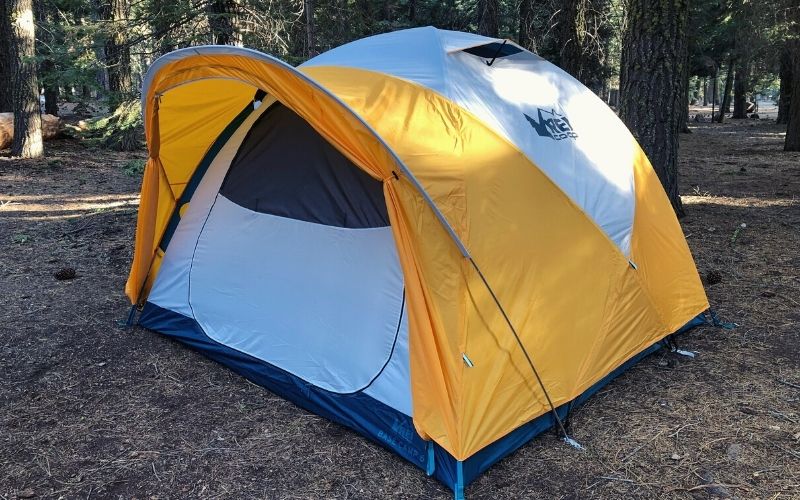
Ventilation
Features in a tent that can help boost ventilation by improving airflow include extensive mesh panels in the canopy of the inner tent body, vents in the rainfly, mesh-lined windows, and double doors.
Ventilation refers to a tent’s ability to let air circulate inside the sleeping area, reducing the risk of stuffiness and condensation.
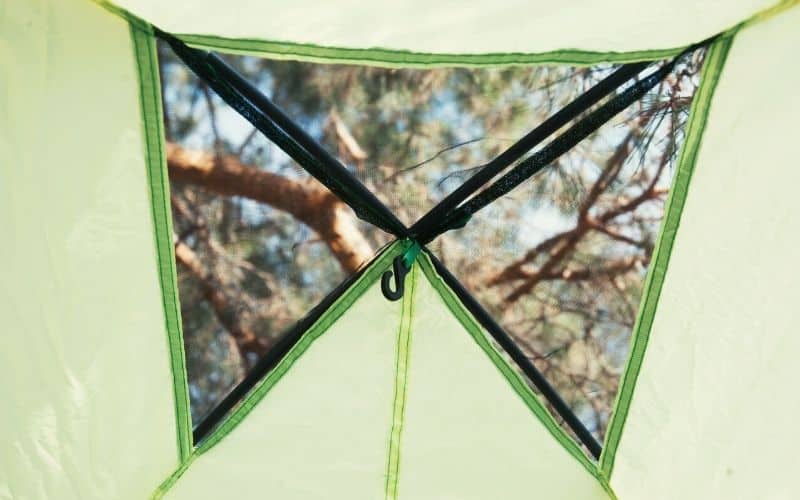
Durability
Tent durability primarily depends on the fabric used in the body and fly, and the material used in the poles.
Fabric
As a general rule, the thicker the fabric, the more durable and robust a tent will be. Fabric thickness is measured in denier (D), with most manufacturers specifying the denier for both the flooring and the rainfly. Some also employ a ripstop weave that helps to prevent tears and punctures.
Ultralight backpacking tents often have rainflys and floors as thin as 15D and 50D respectively, while those on a beefier car-camping tent can be as thick as 200D (fly) and 1000D (flooring).
Because thicker fabric means more weight, the most rugged and hard-wearing six-person tents are typically the heaviest.
Poles
Fiberglass poles are mostly used in budget 6-person tents and are more prone to breaking. Aluminum poles are lighter and more robust but they are also more expensive. Steel poles are the toughest of the bunch, but also the heaviest by far.
All of the tents in our review use aluminum poles except for the Coleman Sundome (fiberglass) and the Caddis Rapid 6 (steel).
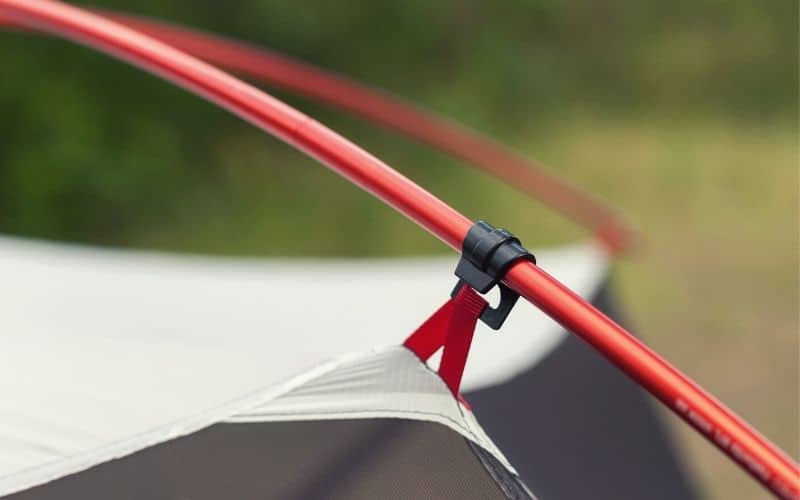
Setting Up & Taking Down
No one wants to spend valuable downtime dealing with the hassle of setting up or taking down a complex shelter.
The most “uncomplicated” tents out there are “instant” or pop-up tents which have poles that are pre-attached to the fabric, allowing for extra-quick pitching.
The next best thing, convenience-wise, are those that have color-coded poles and/or a freestanding design. Color-coded poles make it easy to identify which poles go in which sleeves, while a freestanding tent design means the shelter will stay upright even before being staked out with guylines.
All of the tents featured above have a freestanding design, and the only tent in our review without color-coded poles is the Coleman Sundome. The only “instant” tent in our review is the Caddis Rapid 6, which uses pre-attached poles that enable pitching in 1-2 minutes.
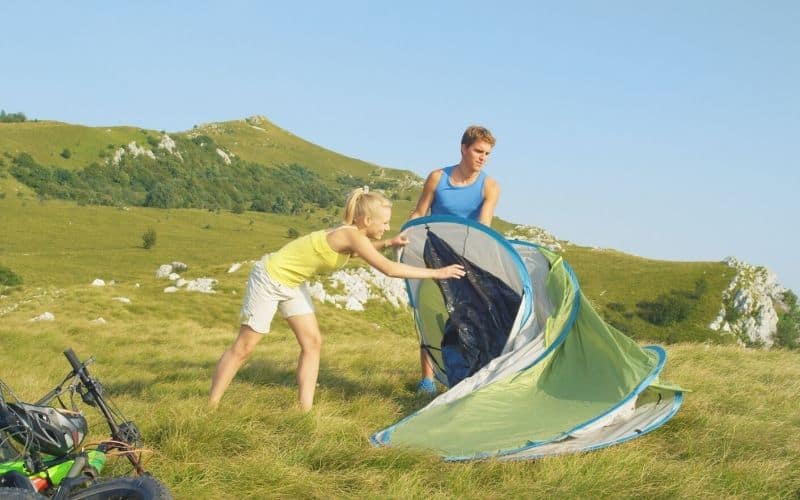
Weight
Manufacturers usually list both the trail weight and the packaged weight of their tents. Packaged weight includes the total weight of the tent and all accessories, such as the inner tent, rainfly, poles, stakes, footprint, and stuff sacks. Trail weight (also known as “minimum weight”) refers only to the weight of the tent body, rainfly, and poles.
The lightest tent in our review is the Coleman Sundome 6 (18 lbs.), and the heaviest is the Caddis Rapid (25 lbs. 8 oz.).
The weight and packed size of your shelter aren’t much of an issue if you’re car camping and only schlepping your sleeping gear a few yards from your vehicle to your pitching point. However, if you’re camping in the backcountry a tent that weighs and takes up as little room as possible in your backpack is preferable.
When buying, bear in mind that lighter tents often scrimp on weather resistance or use flimsier materials to minimize weight.

Storage
Storage space is crucial for three main reasons. First, it enhances livability by freeing up space for occupants in the sleeping area. Second, it helps keep your shelter clean and clutter-free. Third, it helps you locate your gear more easily.
The three main storage features to look for when buying are large vestibules (the bigger the better if camping with lots of gear!), plenty of interior pockets on the tent walls, and a gear loft that lets you free up space by stashing items in the canopy above the sleeping area.
The North Face Wawona 6, which has an array of interior pockets and a whopping 66 sq. ft. of vestibule space, is the best tent for storage of all the tents in our review.
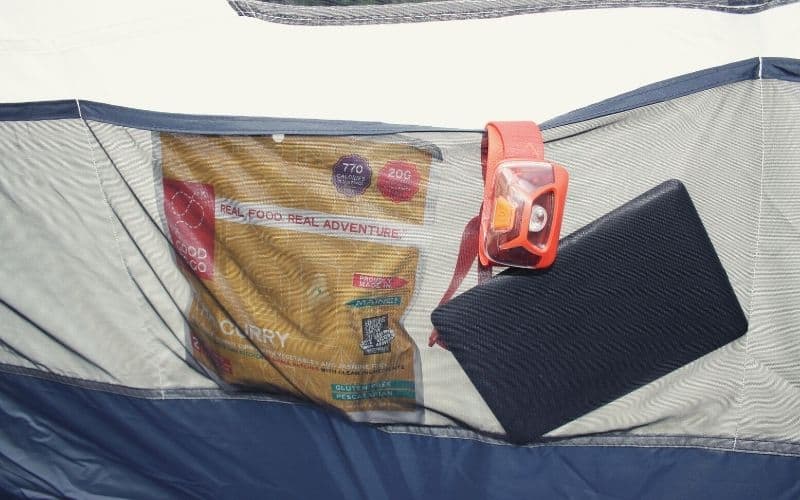
Best 6-Person Camping Tent: The Verdict
Although it comes with a higher price tag, it fulfills every essential criterion. This tent is spacious, waterproof, easy to set up, has generous vestibule space and storage pockets, and features a geodesic dome-style design using durable materials.
If the Base Camp is too expensive, we highly recommend the Coleman Sundome 6. The Sundome has a few shortcomings (a partial-coverage rainfly, cheap poles, and only one door), but it’s very roomy and ideal for summer camping.
If you liked this post, let us know in the comments box below! And if you’d like to share it with your friends, share away!
Save for later!!! ⤵️
